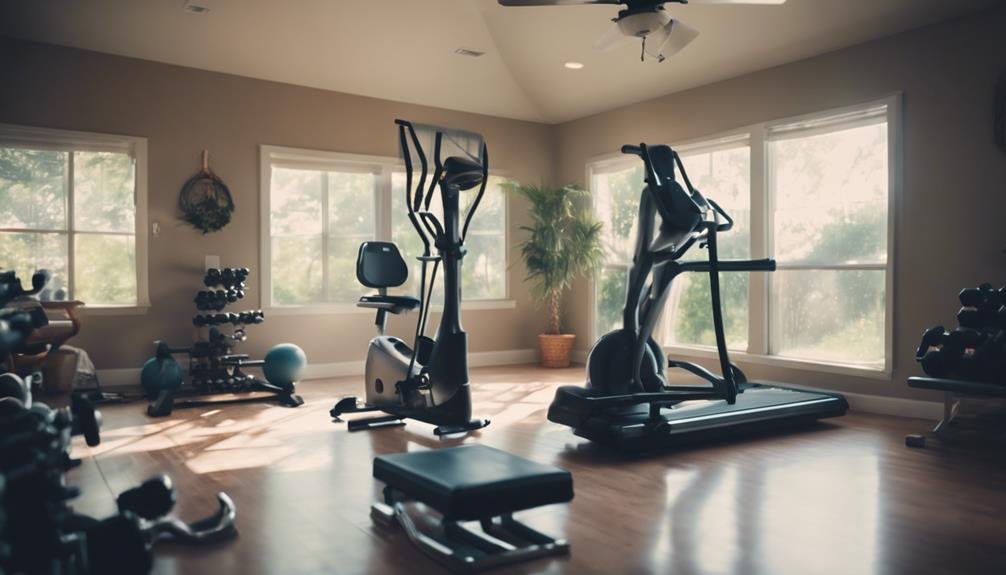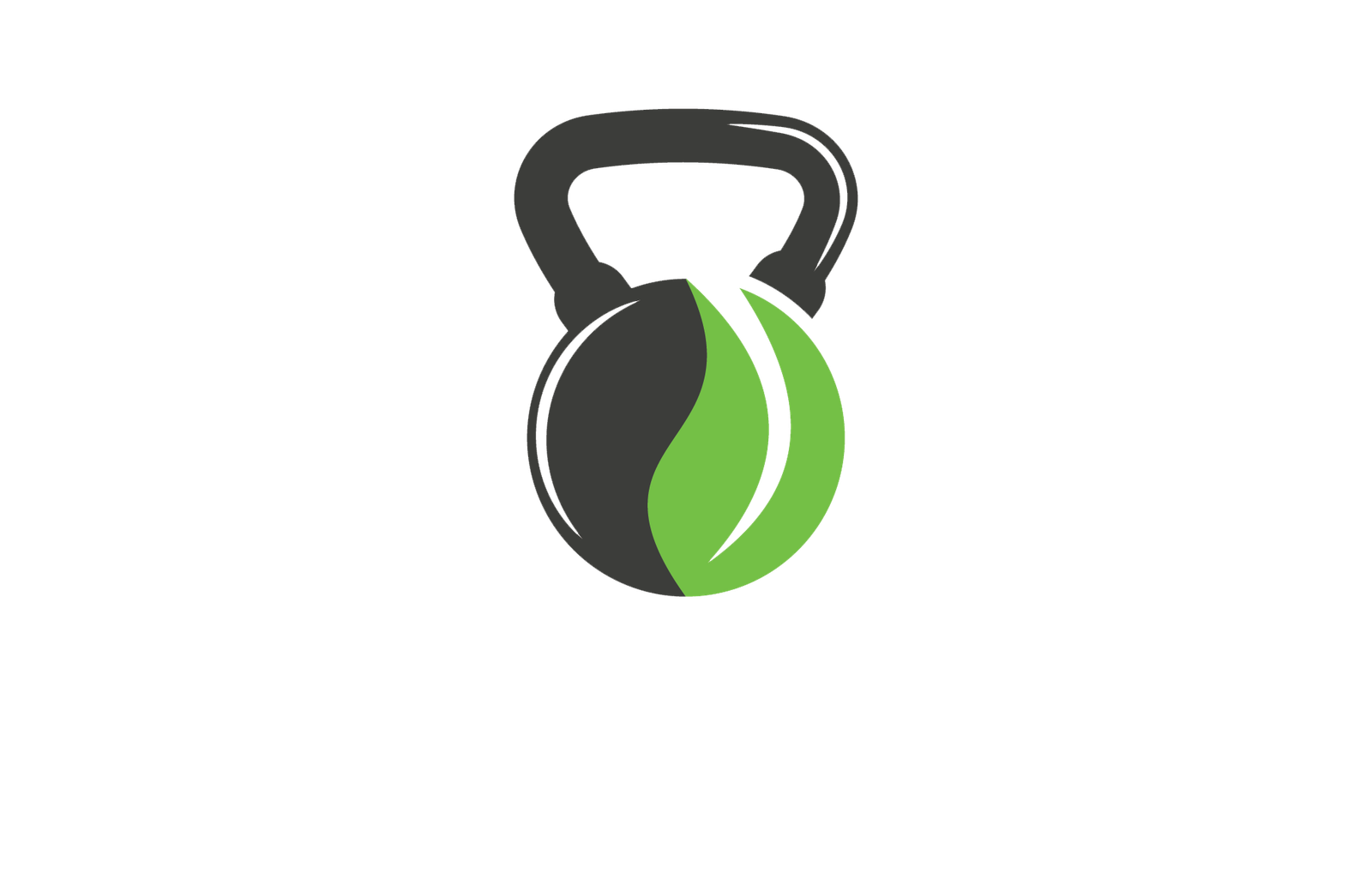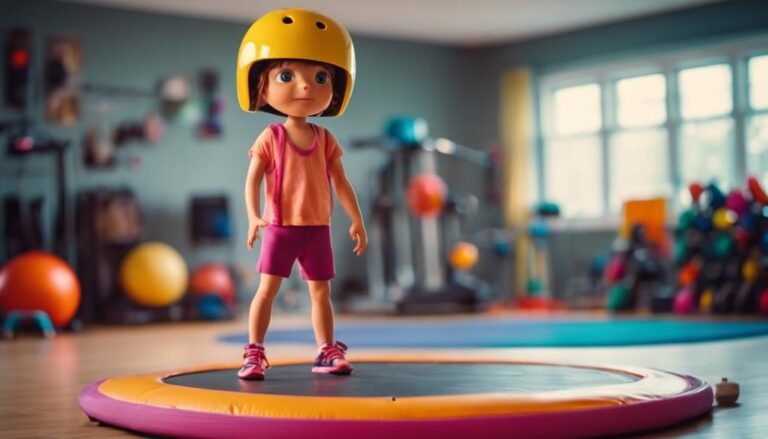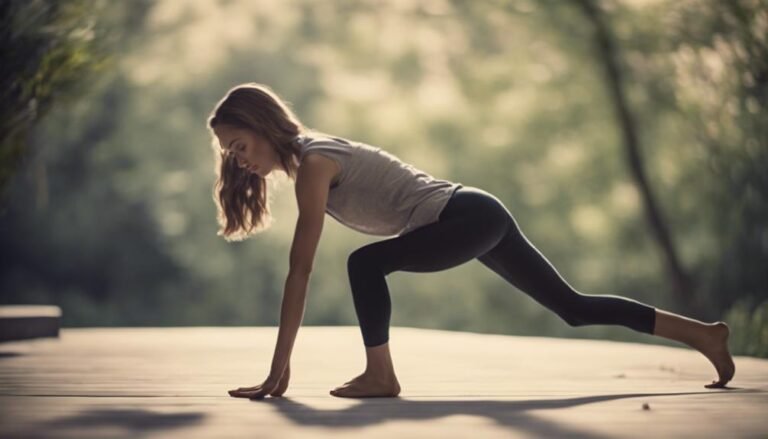Don't miss our holiday offer - 20% OFF!

Ensuring Proper Ventilation in Your Home Gym
Proper ventilation in your home gym is crucial, but what are the hidden dangers of poor air quality, and how can you optimize airflow for a healthy workout space?
We recognize that inadequate ventilation in our home gym can lead to respiratory issues, dizziness, and fatigue, making it essential to prioritize proper ventilation to maintain peak air quality and prevent health hazards. To guarantee a healthy workout environment, we must assess our gym's layout, identifying obstructions and unique ventilation requirements for different workout zones. From natural ventilation strategies to mechanical options, we'll explore the best solutions for our space. By understanding our ventilation needs, we can create a well-designed system that promotes air quality, reduces moisture buildup, and keeps our gym comfy and safe – and there's more to discover.
Key Takeaways
- Evaluate your home gym's layout to determine the most effective ventilation strategy and identify potential airflow obstruction points.
- Inspect the space for clutter, poorly placed mirrors, and equipment that can hinder smooth airflow and promote mold growth.
- Identify unique ventilation requirements for different workout zones, such as cardio, strength training, and stretching areas, to maintain peak air quality.
- Consider fitness goals, like high-intensity interval training (HIIT), which require increased ventilation to prevent respiratory issues and dizziness.
- Choose the right fans, such as axial, centrifugal, or in-line fans, and install them properly to ensure a reliable and efficient ventilation system.
Understanding Ventilation Needs
As we initiate creating an ideal home gym, we must first acknowledge that proper ventilation is not just a nicety, but a necessity. In fact, building codes and regulations emphasize the importance of adequate ventilation in enclosed spaces, including home gyms. This is because exercise and physical activity generate heat, moisture, and air pollutants, compromising air quality and posing health risks. Inadequate ventilation can lead to the buildup of carbon dioxide, carbon monoxide, and volatile organic compounds (VOCs), causing respiratory issues, dizziness, and fatigue. Additionally, poor ventilation can also promote mold growth, corrosion, and equipment damage. To provide a safe and healthy workout environment, we must prioritize ventilation that meets or exceeds local building codes and regulations. By doing so, we can maintain peak air quality, prevent health hazards, and create an ideal home gym that supports our fitness goals.
Assessing Your Home Gym Space
As we assess our home gym space, we need to evaluate the room's layout and identify potential airflow obstruction points. We'll analyze the gym's layout to determine the most effective ventilation strategy, considering factors like equipment placement and traffic flow. Next, we'll inspect the space for any airflow obstructions, such as clutter or poorly placed mirrors, to facilitate smooth airflow.
Gym Space Evaluation
We assess our home gym space by examining the physical layout, identifying potential barriers to airflow, and determining the most effective ventilation strategies. As we evaluate our space, we consider our fitness goals and how they impact our ventilation needs. For instance, if we're focusing on high-intensity interval training (HIIT), we'll need to guarantee our ventilation system can handle the increased heat and moisture generated during these intense workouts. We also identify the different workout zones within our gym, such as the cardio area, strength training zone, and stretching space, to determine the unique ventilation requirements for each zone. By understanding our specific fitness goals and workout zones, we can design a ventilation system that meets our unique needs and provides a healthy, comfortable workout environment. By taking a holistic approach to gym space evaluation, we can create an ideal ventilation strategy that supports our fitness goals and enhances our overall workout experience.
Gym Layout Analysis
With our fitness goals and workout zones in mind, we start by analyzing our home gym's layout to identify any physical barriers that could hinder airflow and ventilation. We want to confirm that our space is optimized for both exercise and respiration. In this assessment, we're looking for any obstacles that could restrict airflow, such as poorly placed equipment or cramped quarters.
Three key considerations for our gym layout analysis are:
- Equipment Placement: We'll evaluate the positioning of our exercise machines, free weights, and other gear to certify they're not blocking air pathways or creating narrow walkways that could impede airflow.
- Space Optimization: We'll assess the overall layout of our gym to identify areas where we can improve ventilation by rearranging equipment or removing any unnecessary obstructions.
- Airflow Pathways: We'll examine the natural airflow patterns in our gym, taking note of any areas where air may become stagnant or trapped, and identify opportunities to enhance air circulation.
Airflow Obstruction Check
When evaluating our home gym space, we'll methodically scan the room to identify any obstacles that could be restricting airflow, taking into account the positioning of mirrors, windows, doors, and any other features that may impact ventilation. This vital step in our ventilation audit guarantees we're creating an environment conducive to effective breathing exercises.
| Obstruction Type | Impact on Airflow | Solution |
|---|---|---|
| Large equipment | Blocks airflow, reducing circulation | Rearrange equipment to create space |
| Cluttered walls | Restricts air movement, hindering ventilation | Remove unnecessary items, optimize storage |
| Insufficient window size | Limits natural ventilation | Consider installing larger windows or adding vents |
| Poor door placement | Disrupts air circulation patterns | Relocate doors or adjust their swing direction |
| Inadequate ceiling height | Restricts vertical airflow | Consider installing fans or adjusting ceiling fixtures |
Identifying Ventilation Challenges
As we set up our home gyms, we often overlook the importance of proper ventilation, which can lead to a range of challenges. We'll examine how insufficient air exchange, poor ventilation design, and lack of air circulation can negatively impact our workout spaces. By understanding these common pitfalls, we can take steps to create a healthier, more comfortable environment that supports our fitness goals.
Insufficient Air Exchange
We often overlook the critical importance of air exchange in our home gyms, which can lead to a buildup of stale air and carbon dioxide. This can have serious consequences on our air quality and, ultimately, our health. Insufficient air exchange can lead to a range of health risks, from mild discomfort to serious respiratory issues.
Here are three ways insufficient air exchange can affect our home gyms:
- Stagnant Air: Without proper ventilation, the air in our home gyms can become stale and stagnant, leading to a buildup of carbon dioxide and other pollutants.
- Moisture Accumulation: Insufficient air exchange can cause moisture to accumulate, creating an ideal environment for mold and mildew to grow.
- Indoor Air Pollution: Inadequate ventilation can lead to the buildup of indoor air pollutants, including volatile organic compounds (VOCs) and particulate matter (PM).
Poor Ventilation Design
Several design flaws in our home gym's ventilation system can severely hinder airflow, leading to poor air exchange and a host of related problems. We've identified common design flaws that can exacerbate ventilation issues, putting our health at risk.
| Design Flaw | Health Risks |
|---|---|
| Insufficient intake vents | Respiratory issues, headaches |
| Improperly sized ducts | Increased CO2 levels, dizziness |
| Inadequate exhaust fans | Heat stress, fatigue |
These design flaws can lead to poor air quality, which can cause a range of health problems. For instance, inadequate ventilation can lead to respiratory issues, headaches, and dizziness. Additionally, poor ventilation design can increase the risk of heat stress and fatigue, which can be detrimental to our workout performance. It's vital to identify and address these design flaws to create a safe and healthy workout environment. By doing so, we can minimize health risks and optimize our home gym's ventilation system for a better workout experience.
Lack of Air Circulation
Identifying ventilation challenges in our home gym begins with recognizing the telltale signs of inadequate air circulation, which can manifest as stuffy air, unpleasant odors, or excessive humidity. It is essential to recognize that a well-ventilated space is crucial for a comfortable and healthy workout environment. However, when air circulation is lacking, it can lead to a stale atmosphere and air stagnation, making our workouts uncomfortable and even unhealthy.
To identify ventilation challenges, we should look out for:
- Stagnant air: If the air in our gym feels stale and unmoving, it may be a sign that air circulation is inadequate.
- Unpleasant odors: Unpleasant smells can be a sign of poor ventilation, as sweat and body odor can become trapped in the air.
- Excessive humidity: High humidity levels can lead to an uncomfortable workout environment and promote the growth of mold and mildew.
Natural Ventilation Methods
By incorporating natural ventilation methods into our home gym design, we can reduce our reliance on mechanical cooling systems and create a healthier, more sustainable workout environment. One effective way to achieve this is through strategic window orientation. By positioning windows on opposite sides of the room, we can create a cross breeze that circulates air and reduces stagnation. This not only improves air quality but also helps to regulate temperature. Additionally, grille installation can be a valuable asset in our natural ventilation arsenal. By installing grilles in strategic locations, we can facilitate airflow and promote convection currents that draw warm air out of the room. This can be particularly effective when combined with clerestory windows or skylights, which allow natural light to enter the space while also promoting ventilation. By incorporating these natural ventilation methods, we can create a more comfortable and sustainable workout environment that benefits both our health and the planet.
Mechanical Ventilation Options
We can supplement our natural ventilation methods with mechanical ventilation options, which provide a reliable and efficient way to exchange stale air for fresh air, even in spaces with limited natural ventilation opportunities. When designing our home gym's ventilation system, we must consider mechanical ventilation options that meet local Ventilation Codes and regulations.
There are several mechanical ventilation options to choose from, including:
- Axial Fans: These fans are ideal for general ventilation and are often used in residential applications. They're relatively inexpensive and energy-efficient.
- Centrifugal Fans: These fans are more powerful than axial fans and are often used in commercial applications. They're suitable for larger spaces and can handle higher pressures.
- In-line Fans: These fans are compact, flexible, and can be installed in a variety of locations. They're ideal for smaller spaces and can be used in conjunction with other ventilation methods.
Choosing the Right Fans
With our mechanical ventilation options outlined, we now need to select the right fans for our home gym's specific needs, taking into account factors such as room size, air exchange requirements, and noise levels. When choosing fans, we must prioritize fan efficiency to minimize energy consumption and maximize airflow. Look for fans with high CFM (cubic feet per minute) ratings to facilitate effective air exchange. Additionally, consider fans with adjustable speed settings to tailor airflow to our gym's unique demands.
Another vital consideration is silent operation. We want to focus on our workout, not be distracted by loud fan noise. Opt for fans with low decibel ratings or those specifically designed for silent operation. Some fans feature advanced noise-reducing technologies, such as aerodynamically optimized blades or specialized mounting systems. By selecting fans that balance efficiency and quiet operation, we can create a superior ventilation system that supports our fitness goals without disrupting our workout environment.
Installing Proper Ventilation Systems
As we move forward with setting up our home gym's ventilation system, it's essential that we carefully plan and execute the installation process to ensure optimal airflow and a healthy workout environment. A well-designed ventilation system is crucial to remove heat, humidity, and pollutants, creating a comfortable and safe space for our workouts.
To ensure compliance with local building codes and regulations, we must consider the following key factors during installation:
- Ventilation codes: Familiarize ourselves with local ventilation codes and regulations to ensure our system meets the required standards.
- System design: Design a system that takes into account the size of our gym, the number of users, and the type of equipment used.
- Airflow calculation: Calculate the required airflow rate to remove heat, humidity, and pollutants, ensuring a healthy and comfortable environment.
Considering Air Purification
Air purification is a critical component of a well-designed ventilation system, and we've got to weigh the type of air purification technology that will best serve our home gym's specific needs. We're looking for a system that can effectively remove pollutants, allergens, and odors, ensuring ideal air quality for our workouts. We'll need to examine filter options, such as HEPA filters, activated carbon filters, or UV light purification systems. Each has its strengths and weaknesses, and we'll need to determine which one will best address our air quality concerns.
For instance, HEPA filters are excellent at removing particulate matter, while activated carbon filters excel at absorbing gases and odors. UV light purification systems, on the other hand, are effective against bacteria and viruses. We'll also need to evaluate factors such as filter replacement costs, maintenance requirements, and noise levels when selecting an air purification system. By carefully evaluating our options, we can create a ventilation system that provides a healthy and comfortable environment for our workouts.
Managing Humidity Levels
As we focus on managing humidity levels in our home gym, we need to start by measuring the current humidity levels accurately. To do this, we'll explore the various humidity measurement tools available, from hygrometers to thermohygrometers. By understanding these tools, we'll be better equipped to develop effective dehumidifying strategies and moisture control methods that maintain a healthy and comfortable workout environment.
Humidity Measurement Tools
We utilize hygrometers to accurately measure the relative humidity levels in our home gym, maintaining ideal conditions for our workouts. Accurate humidity measurement is vital, as excessive moisture can lead to mold growth, equipment damage, and discomfort during exercise. To guarantee precise readings, we employ high-quality humidity sensors, which provide reliable data for perfect humidity control.
Three essential considerations for selecting the right humidity measurement tools are:
- Calibration Methods: Regular calibration guarantees that our hygrometers provide accurate readings. We use certified calibration methods to confirm our devices are functioning correctly.
- Sensor Accuracy: We choose humidity sensors with high accuracy ratings to guarantee reliable data. This is particularly important in our home gym, where humidity fluctuations can notably impact our workout experience.
- Real-time Monitoring: Our hygrometers provide real-time humidity readings, enabling us to respond promptly to changes in humidity levels. This maintains a perfect environment for our workouts.
Dehumidifying Strategies
By maintaining accurate humidity measurements, we can now focus on implementing effective dehumidifying strategies to manage humidity levels in our home gym. One key aspect of dehumidifying is proper dehumidifier placement. We must verify that our dehumidifier is placed in an area that allows for maximum airflow and humidity tracking.
To optimize dehumidification, we can follow these guidelines:
| Dehumidifier Placement Tips | Benefits |
|---|---|
| Place near water sources (e.g., showers) | Reduces humidity from moisture-rich areas |
| Position in central areas for even airflow | Guarantees consistent humidity levels |
| Avoid placing near walls or obstacles | Prevents airflow restriction |
| Consider placing in a well-ventilated area | Enhances dehumidification efficiency |
| Rotate dehumidifier regularly for even coverage | Maintains consistent humidity levels |
Moisture Control Methods
To effectively manage humidity levels in our home gym, we'll explore advanced moisture control methods that integrate seamlessly with our dehumidifying strategies. By implementing these methods, we can prevent dampness and create an environment that's conducive to our fitness goals.
Three essential moisture control methods are:
- Waterproofing: We'll apply waterproof coatings to walls and floors to prevent water seepage and reduce the risk of mold growth, thereby guaranteeing a dry environment.
- Drainage Systems: Installing a proper drainage system facilitates efficient water redirection away from our home gym, reducing the likelihood of water accumulation and subsequent dampness.
- Insulation: Proper insulation of walls, floors, and ceilings helps to regulate temperature and humidity levels, making it easier to maintain a dry and comfortable environment. These methods are worth exploring in our pursuit of a humidity-controlled home gym.
Reducing Moisture Buildup
Moisture buildup can quickly become a major issue in our home gym, so we need to take proactive steps to mitigate its effects. One effective way to reduce moisture buildup is through moisture mapping, which involves identifying areas where moisture tends to accumulate. By mapping these areas, we can target our efforts to reduce moisture buildup.
To take it a step further, we can utilize humidity hacks to reduce moisture buildup. Here are some examples:
| Moisture Mapping Techniques | Humidity Hacks |
|---|---|
| Identify areas with poor air circulation | Use fans to improve air circulation |
| Pinpoint sources of moisture (e.g., showers, saunas) | Install a dehumidifier near these areas |
| Identify areas with high humidity levels | Use silica gel packets to absorb excess moisture |
| Detect hidden moisture sources (e.g., leaky pipes) | Fix any leaks or water damage promptly |
Creating a Well-Ventilated Layout
We design our home gym's layout to maximize airflow and minimize stagnant air pockets. A well-planned layout is vital in creating a well-ventilated space. To achieve this, we consider the following key factors:
- Airflow Paths: We make certain that there are clear pathways for air to circulate throughout the gym, avoiding any obstructions that could hinder airflow.
- Dead Spots: We identify and eliminate any areas where air can become stagnant, such as corners or areas behind equipment.
- Equipment Placement: We strategically place equipment to promote airflow and minimize the creation of dead spots.
Regular Maintenance Tips
By incorporating regular ventilation system checks into our home gym maintenance routine, we guarantee a consistent flow of fresh air and prevent the buildup of stale air and pollutants. This proactive approach certifies our ventilation system operates at peak performance, maintaining a healthy and comfortable workout environment.
We make it a point to conduct daily inspections, checking for any signs of wear and tear, corrosion, or blockages in the ductwork. This vigilance helps us identify potential issues before they escalate into major problems. Additionally, we prioritize filter cleaning as part of our regular maintenance routine. Dirty filters can drastically reduce airflow, making our ventilation system less effective. By cleaning or replacing filters regularly, we maintain ideal airflow and prevent the spread of airborne contaminants.
Overcoming Ventilation Challenges
In our pursuit of a well-ventilated home gym, we often encounter unexpected obstacles that can hinder airflow, including inadequate ductwork, insufficient fan power, and poor system design. These challenges can compromise air quality, making it difficult to maintain a healthy and comfortable workout environment.
To overcome these ventilation challenges, we've developed some effective ventilation hacks:
- Upgrade to a high-powered fan: Installing a more powerful fan can improve airflow and help eliminate stagnant air substantially.
- Optimize ductwork design: Verify that ducts are properly sized, insulated, and sealed to maximize airflow and minimize energy losses.
- Implement air purification systems: Integrate air purification systems, such as HEPA filters or UV light disinfection, to improve indoor air quality and reduce the risk of airborne illnesses.
Frequently Asked Questions
How Often Should I Replace My Air Purification System's Filters?
We typically replace our air purification system's filters every 3-6 months, depending on usage and Filter Quality, adhering to the manufacturer's recommended Replacement Schedule to maintain peak performance and air quality.
Can I Use Dehumidifiers Instead of Ventilation Systems?
"We're not going to sugarcoat it – dehumidifiers aren't a substitute for proper ventilation. While they're great for humidity control, their dehumidifier effectiveness is limited; they can't remove pollutants or exchange stale air, making them an incomplete solution."
Will Opening Windows Compromise My Home Gym's Security?
When opening windows, we consider Window Safety and Burglary Risks, weighing the benefits of ventilation against potential security breaches, ensuring we don't compromise our home's security while promoting airflow.
Are There Any Ventilation Solutions for Basements With No Windows?
"In the dark, damp recesses of our basements, stagnant air lurks, but we can breathe new life into these spaces with ductwork alternatives, such as in-line fans and heat recovery ventilation systems, paired with proper basement insulation."
Can I Install a Ventilation System Myself or Do I Need a Pro?
We decide whether to DIY or hire a pro based on local regulations and our skills; if unsure, we opt for a professional to guarantee a ventilation system that meets local building codes and our home gym's unique needs.
Conclusion
By now, we've broken a sweat getting our home gym ventilation in shape. The finish line is in sight, and we're crossing it with confidence. We've learned to navigate the twists and turns of ventilation, from natural to mechanical methods, and tackled moisture buildup. With our well-ventilated layout and regular maintenance, we're breathing easy. The proof is in the pudding – our home gym is now a comfortable, healthy space to push ourselves to new heights.



